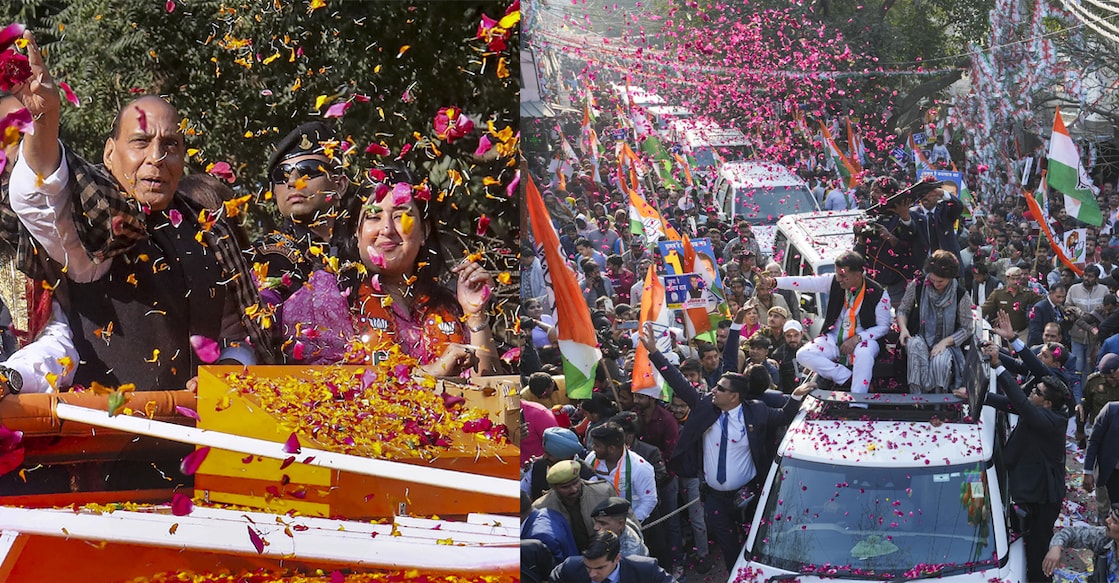Intense campaigning for Delhi polls ends with roadshows, star power, and AI spoofs

Mail This Article
New Delhi: The high-stakes campaign for the Delhi Assembly election concluded at 5 pm on Monday, bringing an end to months of intense electioneering. The campaign was marked by AI-generated memes, sharp political barbs, and a race to attract voters with a slew of freebies, including financial aid for women and the youth.
The ruling AAP, along with its key rivals BJP and Congress, engaged their star campaigners extensively, reported IANS. The BJP’s campaign was spearheaded by Prime Minister Narendra Modi, accompanied by Cabinet Ministers Amit Shah, Rajnath Singh, and Piyush Goyal.
Congress leaders Rahul Gandhi and Priyanka Gandhi Vadra, former Chief Minister Arvind Kejriwal, Punjab CM Bhagwant Singh Mann, and Chief Ministers from various BJP and Congress-ruled states also took part in the election drive. The AAP’s campaign was further bolstered by the presence of cricketer Harbhajan Singh and film actor Shatrughan Sinha.
Key campaign issues revolved around financial aid for women, corruption allegations concerning the liquor scam and 'Sheesh Mahal', unemployment, water and sewage concerns, deteriorating air quality, the pollution of the Yamuna, and free health insurance.
The election narrative prominently featured the competing guarantees of the three major parties—‘Modi ki Guarantee’, ‘Kejriwal ki Guarantee’, and ‘Congress ki Guarantee’—each promising various benefits to secure voter support.
The parties also clashed over accusations of poll code violations, the alleged deletion of voters’ names, the enrolment of suspected Bangladeshis in voter lists, and misinformation campaigns aimed at influencing the electorate.
Among the high-profile constituencies that drew significant attention were the New Delhi seat of AAP National Convenor Arvind Kejriwal and the Kalkaji seat of Chief Minister Atishi.
The campaign saw an unprecedented reliance on AI-generated spoofs and memes, aggressive political rhetoric, and high-energy roadshows.
On the final day of the campaign, the BJP conducted 22 roadshows and rallies across the capital, with PM Modi releasing a video showcasing his interaction with students as part of their concluding efforts to end AAP’s three-term rule.
The AAP, meanwhile, focused on Chhatarpur and Kalkaji constituencies, with Kejriwal addressing public meetings and releasing videos alleging attempts to manipulate EVMs. Throughout its campaign, the AAP raised concerns over poll code violations and alleged bias by the Election Commission in favour of the BJP. The party also highlighted its development model, offering 15 guarantees, including financial aid for women and other welfare measures.
Voting for the 70-member Delhi Assembly is scheduled for February 5, with results to be announced on February 8. In the outgoing House, the AAP holds 62 seats, while the BJP has eight.
According to the Delhi Chief Electoral Officer (CEO), 1.56 crore voters are eligible to cast their ballots across 13,766 polling stations. This includes 83.76 lakh men, 72.36 lakh women, and 1,267 third-gender voters. The total number of candidates contesting the election stands at 699, up from 672 in 2020.
For the first time in India, the Election Commission has introduced a Queue Management System (QMS) application, enabling voters to monitor real-time crowd levels at polling stations via the Delhi Election - 2025 QMS app.
Additionally, nearly 7,000 senior citizens and persons with disabilities have already exercised their franchise through the home voting facility ahead of polling day, even before the first EVM button is pressed.

